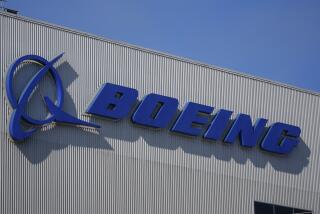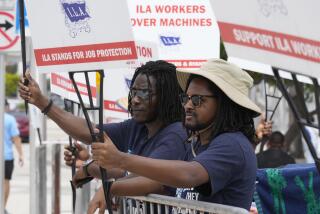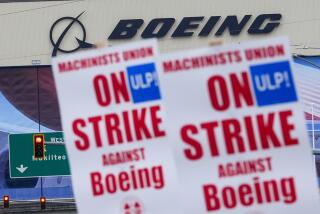UAW Extends Ford Pact, Averting Strike
DEARBORN, Mich. — The United Auto Workers and Ford Motor Co. agreed to a day-to-day extension of their three-year contract, averting the threat of a strike at midnight Monday affecting 104,000 auto workers.
“We look obviously, optimistically at reaching an agreement, but if we don’t make it, we still have all our other options available to us,” UAW President Owen Bieber told a news conference 40 minutes before the contract was to expire.
“We have made substantial progress on our central issue” of job security, Bieber said.
‘Looks Pretty Decent’
Richard Downey, president of UAW Local 897 in Buffalo, N.Y., said Ford made a new offer on job security that “looks pretty decent.” He added that it would take a day or so for union officials to study it.
Ford Vice President Peter Pestillo declined to comment on the negotiations. “Nothing is done until everything is done,” Pestillo said. “It takes courage for union leaders to extend a contract,” he said.
Stanley Surma, Ford labor relations director, said: “We’ve agreed to continue working toward a settlement. Both parties have worked extremely hard in addressing those issues. . . . We just kind of got worn out.”
Surma said the two sides will return to the table this morning.
The extension agreement came as local UAW leaders waited by union hall phones to learn whether they were striking or staying on the job. Many continued local contract discussions but at a slow pace, as both sides awaited the national outcome.
Meanwhile, in Toronto, the Canadian Auto Workers union Monday rejected a last-minute contract offer from Chrysler’s Canadian subsidiary, launching a strike at midnight affecting 10,000 Canadian auto workers.
Industry analysts had predicted that if there was a strike against Ford, it would be short. Under a strike, Ford’s supply of cars and trucks would last about 56 days, a low inventory by industry standards.
The UAW last struck Ford in 1976, a walkout that lasted 28 days and involved 160,000 hourly U.S. workers, over the union’s demand for paid personal holidays and wage increases.
The UAW opened negotiations with Ford and General Motors Corp. in late July. On Aug. 31 the union chose Ford as its strike target--the company it will settle with first.
In a process called pattern bargaining, the union negotiates first with the company it believes can give it the best deal and then tries to force that contract on the remaining company. GM, however, has insisted that it has different problems and needs a separate contract.
GM Contract Extended
GM’s contract has been extended until a new deadline that will be set once Ford workers begin voting on a settlement.
At both companies, the union’s primary concern is greater job security. Ford, which has 104,000 UAW workers, and GM, which has 335,000, both import cars from Korea and Mexico. They also are planning or producing cars in joint ventures with Japanese auto makers and want the freedom to buy more parts from outside companies.
The union demanded that Ford guarantee it will keep employment at its current level of 108,000 UAW workers--the 104,000 auto workers and 3,800 Rouge Steel workers--throughout the life of a new three-year contract.
Ford has 7,248 workers on layoff. However, the world’s most profitable auto maker, whose half-year earnings rose about 65% to $2.99 billion this year, has been running its plants at 120% capacity.
Under the union’s proposal, Ford would be unable to lay off workers even if Ford’s sales slowed dramatically.
The union also sought a return to an annual percentage increase in the base wage rate--$12.83 an hour for assembly workers--and a halt to “outsourcing,” or shifting production of parts and vehicles to outside companies.
The typical assembly worker at Ford receives $39,000 a year, including overtime, vacation, holiday pay and other benefits, the company said. In addition, Ford workers received an average $2,100 in profit sharing in 1986.






